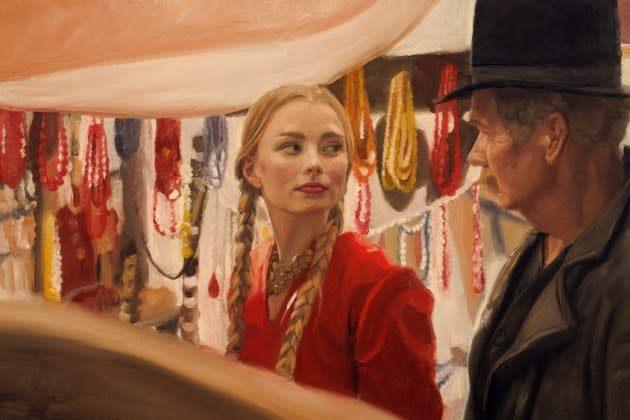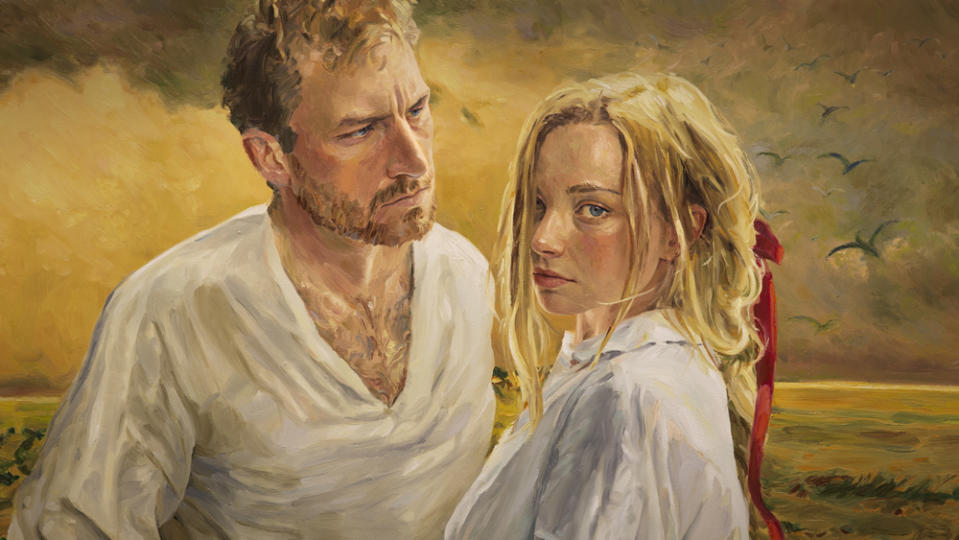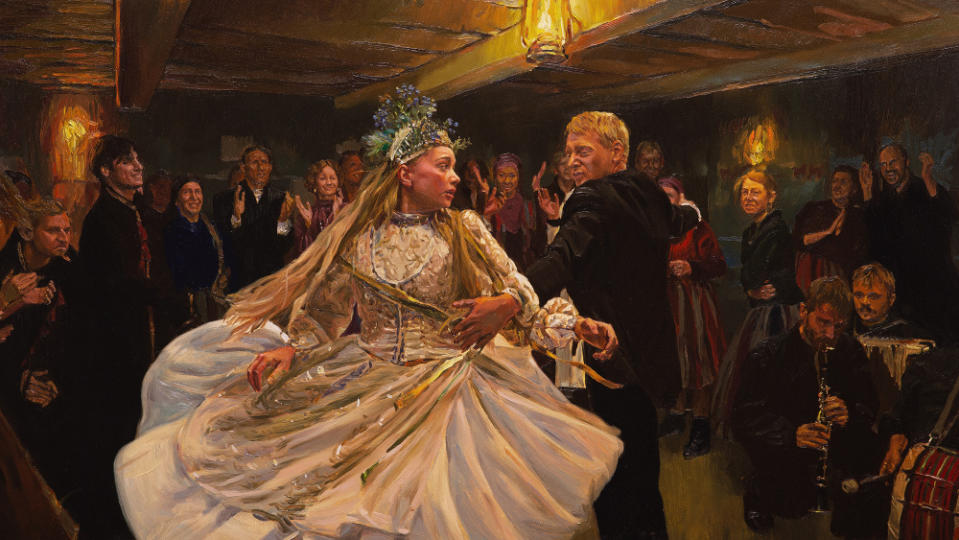‘The Peasants’ Directors on How ‘Loving Vincent’ Follow-Up Takes Its Groundbreaking, Hand-Painted Animation Style to Another Level (EXCLUSIVE CLIP)
- Oops!Something went wrong.Please try again later.
- Oops!Something went wrong.Please try again later.
- Oops!Something went wrong.Please try again later.
- Oops!Something went wrong.Please try again later.

With the long-awaited follow-up to their Oscar-nominated animated feature “Loving Vincent,” directors D.K. Welchman (formerly known as Dorota Kobiela) and Hugh Welchman revisit the striking, hand-painted animation technique that dramatically brought the paintings of Vincent Van Gogh to life in their groundbreaking debut, which grossed more than $50 million globally.
But “The Peasants,” which is based on the novel by Nobel Prize-winning Polish author Władysław Reymont and premieres Sept. 8 at the Toronto Film Festival, is a work of far greater scope and ambition. “The scale of the film is different,” says Hugh. “Whereas ‘Loving Vincent’ was very much talking heads…this is about a community with some huge set pieces. We have battles, lynchings, big dance numbers, big weddings. It involves many more people, much more dynamic action in a totally different approach to the use of camera than ‘Loving Vincent.’”
More from Variety
Polish Filmmakers Wrestle With the Weight of History, Even As It Unfolds Before Their Eyes
A Mother's Quest for Justice in the Arabian Gulf Takes Centerstage in Toronto Selection 'Yellow Bus'
Set toward the end of the 19th century and lavishly told over the course of four seasons, “The Peasants” tells the story of a young woman struggling for her independence in a village where roles are rigidly defined by family, faith and tradition. Below, you can take an exclusive, behind-the-scenes look at how the filmmakers brought her story to life:
Because it was adapted from Reymont’s beloved novel, which was recently released in a new English-language translation by Penguin, “The Peasants” marks a radical departure from its predecessor. “We approached ‘Loving Vincent’ as a story built around very particular paintings of Vincent Van Gogh — we created the story around it,” says D.K. “Here, we had the story and the whole film structure built first, and then we had to find the visual key to represent it.”
To do that, the filmmakers turned to a wide repertoire of realist and pre-Impressionist paintings, drawing from the work of artists from the Young Poland movement, a modernist period roughly spanning the years from 1890-1918. They were equally inspired by the evocative language of the novel itself, which “reads like a painting” in its vivid, descriptive passages, according to Hugh.
“Everything is a bit brighter and more painterly and more beautiful [than real life] in the way that Reymont describes it,” he says. “I think that’s the reason why it was such a good fit for us in terms of painting animation.”

The filmmakers first shot a live-action feature film and then hand-painted the footage onto canvas, working with a team of more than 90 animators in four countries, led by head of animation Piotr Dominiak. “The difficulty level of the painting was much higher here. We were very surprised about how different it was,” says Hugh. D.K. adds: “The only similarity is that we are painting oil on canvas.”
Working from studios in Poland, Serbia, Lithuania and Ukraine, the animators tallied more than a quarter of a million man-hours between them, painting under two frames per day — half the output they were able to achieve on “Loving Vincent.” Nearly three-quarters of the painters employed on that film ultimately had to leave “The Peasants” “because they didn’t have the techniques, the skills to reach this level of realism,” says D.K.
The production’s Kyiv studio, meanwhile, had to be shut down after the Russian invasion and the painters evacuated to safety. The studio was reopened last summer, as fighting eased in the capital, but Russian bombardment of critical infrastructure left the city plunged in darkness; the producers launched a Kickstarter campaign to buy a generator, so that the studio would stay lit and heated through the bitter Ukrainian winter.
Spiraling costs — due in part to the war’s impact — forced the producers to scramble for additional financing, partly to ensure their painters’ rates kept pace with inflation. “There was a lot of support,” says producer Sean Bobbitt of Breakthru Films, who credits the Polish Film Institute, the Polish National Foundation and Poland’s National Center for Culture among the donors who helped “bring [the film] over the finish line.” “That our work was born through these very difficult circumstances of COVID, and the war, and then inflation is, I think, beautiful in itself,” he adds.
Though the stunning, hand-painted animation is what’s likely to wow audiences, D.K. says the live-action shoot was instrumental in bringing the world of “The Peasants” to the screen. Principal photography lasted eight weeks and largely took place on a sound stage utilizing green screens. In order to reduce waste — and costs — partial sets were built using recycled materials. During production, cast had to be continually reminded not to lean against the fragile walls.
Because the novel is set over the course of a year, the Welchmans wanted their film to emphasize the rich palette of the changing seasons in the Polish countryside. Rather than stick to the rigid demands of a period drama, costume designer Katarzyna Lewinska (“EO,” “Silent Twins”) was given “poetic freedom” to create a wardrobe that was inspired by the colors of each season, a process that D.K. likens to “bringing our imagination to the existing world that’s described by Reymont.”

A pivotal decision came in the wedding dress worn by Jagna, the movie’s heroine, a dreamy young artist who’s been forced to marry a wealthy, widowed landowner despite her love for his son. Lewinska’s original design was inspired by the traditional dresses of the era. But then lead actress Kamila Urzędowska, in her first major role, stepped in.
“She said, ‘I would like this to be more Vera Wang,’” says D.K. “And the costume maker was like, ‘Okay, we’re in a Polish village in the 19th century. Where the hell should I put Vera Wang?’”
“I said, ‘I don’t care. We need to put Vera Wang in it,’” says Hugh, laughing.
“This is the way he expressed it: ‘It needs to be big, it needs to be incredible,’” says D.K. “And it was such a great idea because it brought so much to the character and to what Jagna feels. Because her freedom is being taken from her, and then she puts this dress on, she starts dancing with her husband, and she starts to feel that she is the fairest woman in the village. She is the most important one. It comes out in her character.”
Captured on film, that feeling would be translated to canvas and stirringly brought to life on screen. “Everything is driven by the actors and their emotions. It’s driven by the costumes that we created, the sets we created,” says D.K. “It was a huge production.”
Best of Variety
Sign up for Variety’s Newsletter. For the latest news, follow us on Facebook, Twitter, and Instagram.

